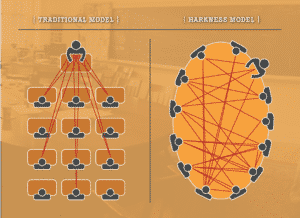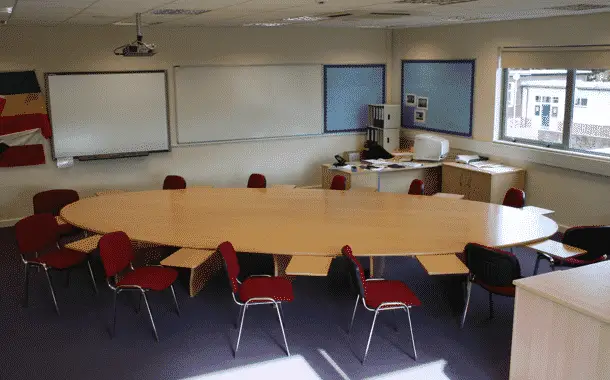How Much Does a Harkness Table™ Cost?
Last Updated on February 16, 2024
Written by CPA Alec Pow | Content Reviewed by ![]() CFA Alexander Popinker
CFA Alexander Popinker
The Harkness Table is a staple of many modern classrooms and learning environments. This oval or round table facilitates discussion-based learning, allowing students to actively engage with their peers and instructors.
But how much does a Harkness Table actually cost? In this article, we’ll explore Harkness Table pricing, features, benefits, and more to help you determine if investing in one of these tables is right for your educational setting.
A Harkness Table can range in price from $2,000 on the low end for a basic model to over $15,000 for a large, customized premium table. Factors like size, materials, and customization affect the overall cost. The philosophy behind the Harkness method emphasizes collaboration and student-driven learning, making this a valuable investment for many schools. Read on to learn what impacts the price of these iconic tables.
How Much Does a Harkness Table™ Cost?
- Entry-level – Expect to pay around $2,000 for a standard 6-8 person Harkness Table made from laminate or other cost-effective materials.
- Mid-range – For a hardwood table seating 10-12 students, plan on spending $6,000 to $10,000. Customization adds to the overall price.
- Premium – Large custom-built Harkness Tables with premium woods or specialty materials can cost $12,000 to $15,000+. Unique designs increase the price.
The size, materials, and construction quality all impact the price of a Harkness Table. Larger tables with greater seating capacity or specialty shapes cost more. Premium woods like mahogany or walnut have a higher price than laminate or veneer surfaces. And ordering a completely custom table adds to the overall investment.
Features of a Harkness Table
Harkness Tables have an iconic oval or round shape designed to facilitate conversation. The average size seats between 6 and 12 students, though larger and smaller versions are available. Most feature a smooth, laminate tabletop surface, but wood veneer and solid wood are popular options. The base is often made of a durable metal like steel. Casters allow mobility.
When ordering a Harkness Table, consider:
- Size – How many students will need to sit? Determine ideal dimensions.
- Materials – Select laminate, veneer, solid wood, or other designer surfaces.
- Customization – Add school logo; choose base, edge & caster options.
- Shape – Oval or round; customize curvature for perfect fit.
With so many options, you can tailor your Harkness Table to match your school’s needs and budget.
Benefits of Using Harkness Tables in Education
There are many reasons why Harkness Tables create an ideal learning environment:
- Enhanced engagement – The circular shape facilitates discussion, keeping students engaged.
- Inclusive participation – Students can see and interact with peers and instructors.
- Collaborative learning – Students learn actively through peer-to-peer discussion.
- Student-driven lessons – Learners play an active role in driving conversation topics.
- Critical thinking skills – Discourse promotes critical analysis and evaluation abilities.
When compared to traditional row seating, the Harkness method fosters more student involvement, improving comprehension and retention. The initial investment pays off through better educational outcomes.
Factors to Consider When Purchasing a Harkness Table
 If you’re ready to invest in a Harkness Table, keep the following in mind:
If you’re ready to invest in a Harkness Table, keep the following in mind:
- Classroom size – Measure your space and purchase an appropriately sized table. Allow room for chairs.
- Quality materials – Opt for durable, high-quality woods and laminates for long-term use.
- Intended use – Will this be used daily? Select materials to withstand active learning.
- Customization – Add your school logo or choose custom colors to show school spirit.
- Budget – Prices range widely; decide how much you can invest to get the right table.
Take time to evaluate your needs and budget to select the ideal Harkness Table for your educational environment.
Alternatives to Harkness Tables
If a Harkness Table is outside your budget, consider:
- Seminar tables – Rectangular tables can seat up to 20 students for discussion-based learning. The price is $1,500 – $4,000.
- Modular tables – Arrange movable tables in circles or ovals for flexibility. $500 – $1,500 each.
- Small group tables – Break students into smaller groups for discussion at separate tables. As low as $250 per table.
While these don’t offer the same experience as a Harkness Table, they provide budget-friendly alternatives. The convenience of rearrangeable smaller tables also appeals to some schools.
Where to Purchase Harkness Tables
Reputable suppliers like MooreCo Inc. and Virco Inc. offer a range of Harkness Table models, materials, sizes, and customization options. Expect to pay over $2,000 for their standard sizes. Mid-range models run $5,000 – $8,000. For completely bespoke tables, contact a specialty educational furniture builder. Their custom Harkness Tables start around $10,000.
You might also like our articles about the cost of counseling supervision, trade school, or Primrose tuition.
Shop around and compare prices to find the best value based on your budget and needs. With an iconic table facilitating collaborative learning, your students will reap the benefits of this investment for years to come.
Final Words
The Harkness Table facilitates an engaged, student-driven learning environment. While prices reaching $15,000+ may seem high, the benefits of peer-to-peer discussion and critical thinking skill building make this a worthwhile investment for many schools.
Consider your needs, customize to your specifications, and purchase quality materials for long-term durability when investing in a Harkness Table. With options at every price point, you can find the perfect table to inspire collaborative learning in your classroom.
Frequently Asked Questions
What size is the Harkness table?
Harkness Tables come in a range of sizes to fit classrooms and budgets. A standard 6-8 person table is often 7-8 feet wide. For 10-12 students, a 10 foot diameter is common. Large custom models can be 12 feet or more wide. Measure your space and determine how many students need to be seated when selecting the right size Harkness Table.
What are the benefits of Harkness table?
The circular shape and collaborative set-up of the Harkness Table offers many benefits for active, student-driven learning including enhanced student engagement through discussion; increased participation and inclusiveness; improved critical thinking and comprehension; and an interactive, collaborative learning atmosphere.
What is the Harkness table style?
Harkness Tables have a distinctive oval or round shape with seating all the way around the curved exterior. They usually feature a smooth laminate or wood veneer tabletop surface, often in a maple or walnut stain.
The base is made of durable metal, and casters allow for easy mobility. Harkness Tables can be customized with school colors, logos, and materials. Their unique shape facilitates dynamic discussion-based learning.


Leave a Reply
Want to join the discussion?Feel free to contribute!